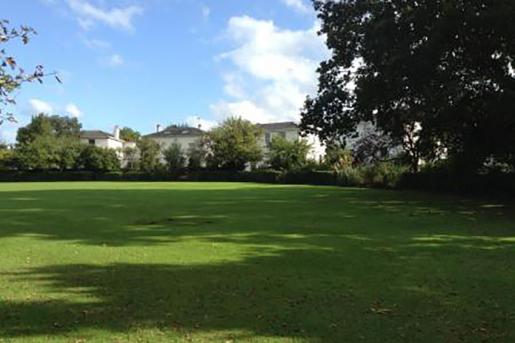- Communal gardens
- C19
Private C19 communal garden maintained by the residents association.
Baring Crescent is a spaciously set out group of detached stucco houses, built by W. Hooper, described as ‘Superior Cottages ’of c.1820 . Until about 1850 the cottages stood on their own overlooking the City across the fields. The pleasure grounds were laid out at the same time; this communal garden retains the shape shown on a map of 1850 i.e. a curved half oval on the east side and a wavy line joining the ends of the curve on the west side. The central area is mown grass with a metre wide sandy path around the edge. There are mature trees on all sides; shrubs edge the front of the continuous planting on the perimeter, effectively making an informal hedge, with benches inserted on the east side. Behind the hedge at the northern end there is a small play area with swings and paths. New trees here include several good paperbark silver birches. On the west side behind the hedge there is an attractive newly planted area on either side of a snaking path. The active householders’ committee employs a gardener from the Exeter University Estates Team to maintain the lawn and hedges; he is gradually replacing some of the elderly evergreen shrubs with deciduous shrubs with attractive foliage. During the Exeter Blitz of 1942 two houses at the western end were destroyed, as was a significant part of the adjoining St. Luke’s Training College. Small modern houses now occupy the bomb site but are well back from the Crescent building curve and so not too intrusive. In the late 1940s a Metasequoia glyptostroboides was planted by the Vice-Chacellor of the University and is now very tall indeed. It was an early planting of this species and could be the tallest in the UK.
Nos 1 & 4, 6-12 Baring Crescent listed Grade II
Cherry & Pevsner: The Buildings of England – Devon, 1989: 429

